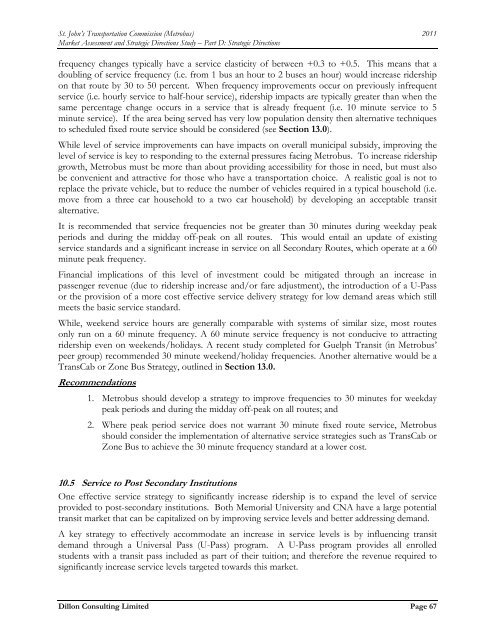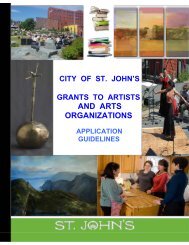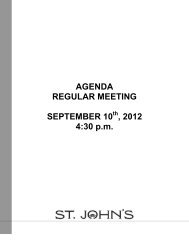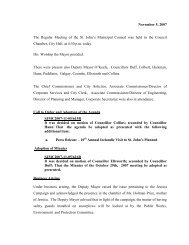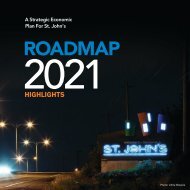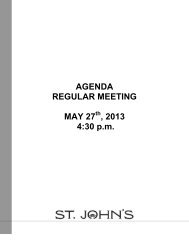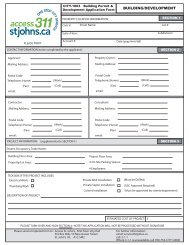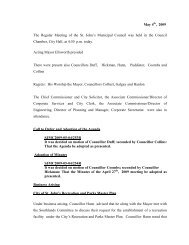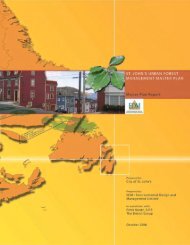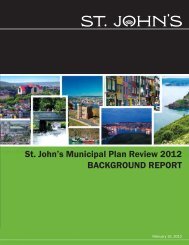Metrobus Transit Study.pdf - City of St. John's
Metrobus Transit Study.pdf - City of St. John's
Metrobus Transit Study.pdf - City of St. John's
Create successful ePaper yourself
Turn your PDF publications into a flip-book with our unique Google optimized e-Paper software.
<strong>St</strong>. John’s Transportation Commission (<strong>Metrobus</strong>) 2011<br />
Market Assessment and <strong>St</strong>rategic Directions <strong><strong>St</strong>udy</strong> – Part D: <strong>St</strong>rategic Directions<br />
frequency changes typically have a service elasticity <strong>of</strong> between +0.3 to +0.5. This means that a<br />
doubling <strong>of</strong> service frequency (i.e. from 1 bus an hour to 2 buses an hour) would increase ridership<br />
on that route by 30 to 50 percent. When frequency improvements occur on previously infrequent<br />
service (i.e. hourly service to half-hour service), ridership impacts are typically greater than when the<br />
same percentage change occurs in a service that is already frequent (i.e. 10 minute service to 5<br />
minute service). If the area being served has very low population density then alternative techniques<br />
to scheduled fixed route service should be considered (see Section 13.0).<br />
While level <strong>of</strong> service improvements can have impacts on overall municipal subsidy, improving the<br />
level <strong>of</strong> service is key to responding to the external pressures facing <strong>Metrobus</strong>. To increase ridership<br />
growth, <strong>Metrobus</strong> must be more than about providing accessibility for those in need, but must also<br />
be convenient and attractive for those who have a transportation choice. A realistic goal is not to<br />
replace the private vehicle, but to reduce the number <strong>of</strong> vehicles required in a typical household (i.e.<br />
move from a three car household to a two car household) by developing an acceptable transit<br />
alternative.<br />
It is recommended that service frequencies not be greater than 30 minutes during weekday peak<br />
periods and during the midday <strong>of</strong>f-peak on all routes. This would entail an update <strong>of</strong> existing<br />
service standards and a significant increase in service on all Secondary Routes, which operate at a 60<br />
minute peak frequency.<br />
Financial implications <strong>of</strong> this level <strong>of</strong> investment could be mitigated through an increase in<br />
passenger revenue (due to ridership increase and/or fare adjustment), the introduction <strong>of</strong> a U-Pass<br />
or the provision <strong>of</strong> a more cost effective service delivery strategy for low demand areas which still<br />
meets the basic service standard.<br />
While, weekend service hours are generally comparable with systems <strong>of</strong> similar size, most routes<br />
only run on a 60 minute frequency. A 60 minute service frequency is not conducive to attracting<br />
ridership even on weekends/holidays. A recent study completed for Guelph <strong>Transit</strong> (in <strong>Metrobus</strong>’<br />
peer group) recommended 30 minute weekend/holiday frequencies. Another alternative would be a<br />
TransCab or Zone Bus <strong>St</strong>rategy, outlined in Section 13.0.<br />
Recommendations<br />
1. <strong>Metrobus</strong> should develop a strategy to improve frequencies to 30 minutes for weekday<br />
peak periods and during the midday <strong>of</strong>f-peak on all routes; and<br />
2. Where peak period service does not warrant 30 minute fixed route service, <strong>Metrobus</strong><br />
should consider the implementation <strong>of</strong> alternative service strategies such as TransCab or<br />
Zone Bus to achieve the 30 minute frequency standard at a lower cost.<br />
10.5 Service to Post Secondary Institutions<br />
One effective service strategy to significantly increase ridership is to expand the level <strong>of</strong> service<br />
provided to post-secondary institutions. Both Memorial University and CNA have a large potential<br />
transit market that can be capitalized on by improving service levels and better addressing demand.<br />
A key strategy to effectively accommodate an increase in service levels is by influencing transit<br />
demand through a Universal Pass (U-Pass) program. A U-Pass program provides all enrolled<br />
students with a transit pass included as part <strong>of</strong> their tuition; and therefore the revenue required to<br />
significantly increase service levels targeted towards this market.<br />
Dillon Consulting Limited Page 67


